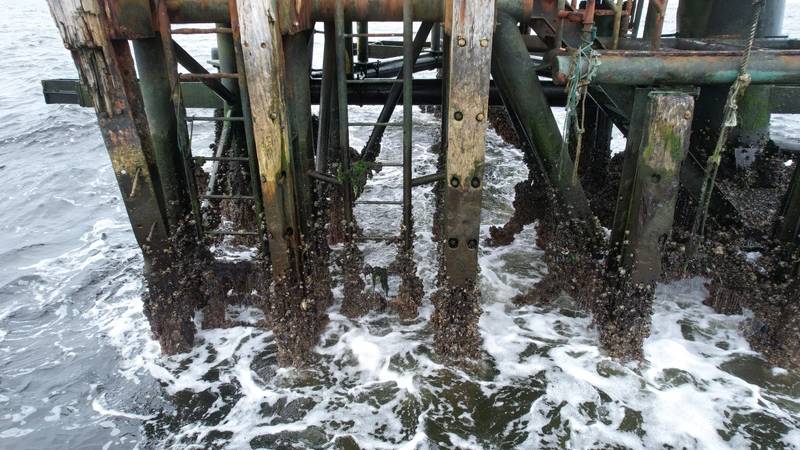FROM RIG TO REEF
Turning an oil platform in Angola into an artificial reef
The abandoned platform.
Photo courtesy EQSHaving reached the end of its service lifecycle, the Safueito Field had its Cessation of Production (CoP) in 2003 while its production well was plugged and abandoned (P&A) in 2006.
Part of the facilities will now become an artificial reef.
This project is comprised of several phases. EQS (Environmental Quality Services) is proud to have been selected by one of the most important oil and gas companies operating in Angola to lead the initial phases of the project that constitutes the first decommissioning of a platform in the African continent. It is worth noting that this activity is undertaken under the auspices of The Ministry of Mineral Resources, Oil and Gas of Angola.
EQS helps offshore energy clients navigate the complex environmental regulatory landscape including compliance, HSE subjects, and business liabilities.
In compliance with industry standards the top side is to be prepared, fitted and dismantled and taken ashore. The jacket is to be toppled and laid on its side on the seabed ready to become an artificial reef.

The platform is already presenting significant marine growth.
The overall facilities consist of an unmanned platform, a production well with its protection dome, two pipelines (4" and 8") and an umbilical.
The first phase started in 2021 by EQS, has been to collect a vast amount of baseline data concerning the condition of the infrastructure, the equipment and surrounding maritime environment.
Best Reef Location
The mission has involved a multi-disciplinary team from different companies and sectors of activity, including marine biology, hydrographic surveys, quality inspectors and personnel specialised in survey equipment such as a drone and a Saab Seaeye Falcon underwater robot.
EQS selected the Seaeye Falcon as it can handle an array of cameras, sensors, tooling and complex data gathering systems that can be easily reconfigured by the Falcon’s iCON™ intelligent module-focused distributed control architecture.
Along with its camera configuration, the Falcon has been fitted with an Imagenex 881A digital multi-frequency profiling sonar.
Hydrography and bathymetry
The objectives of the survey were to map all the underwater components, including checking the wellhead and pipelines.
The hydrography and bathymetry work included the use of three pieces of equipment: multibeam, IMU (Inertial Motion Unit) and SV (Sound Velocity) Sounder which were deployed in the vessel's moonpool structure.
General condition and surrounding maritime environment
Inspection of the platform’s integrity was an important objective, mainly due to the fact it has been abandoned for several years and exposed to the mercy of the maritime environment.
Before sending personnel to the platform, it was inspected by EQS using a drone to survey the immediate area and the platform’s general condition including the surrounding maritime environment.
The tripod and jacket were successfully inspected using the Seaeye Falcon. The mud mats, piles, riser and pipeline could not be inspected due to significant sedimentation. There is already significant marine growth throughout the structure and marine life is abundant.
Sampling activities
One of the objectives of this first phase was to determine the area baseline environmental condition, so water and sediment samples were taken in several stations and at different depths.
The plan called for five sampling stations around the platform, the wellhead and at the artificial marine reef construction site pre-determined location.
Video images from Falcon.
Video images from the Falcon already show an abundance of marine life.
The water samples were analysed for pH, temperature, electrical conductivity, salinity (sodium chloride), dissolved oxygen, turbidity, radioactivity (mSv), chlorophyll, suspended matter, total hydrocarbons (TOC and TIC), chemical oxygen demand (COD), total dissolved solids, phenols, cyanides and nutrients (Ammonia, Nitrates, Total Nitrogen, Orthophosphates, Total Phosphorus).
Niskin bottles were used for water collection.
Seabed sediment samples were taken using a Smith-McIntyre Grab sampler, which allowed the collection of a representative sample of the surveyed area.
The sampling activity also focused on the collection of biological matter, namely zooplankton, phytoplankton, and benthos collected using a WP-2 net.
Conclusions
The pending issues and evidence resulting from the first phase of technical and operational monitoring of the decommissioning of the Safueiro field will be addressed under the new plan already developed by EQS.
The platform is already presenting significant marine growth.
New planning is in place to continue works of the second phase, which will include the correction of some findings identified in the first phase, NORM assessment, clearing an area of fish nets, restoring platform signalling and marking, positioning of signal buoys and confirmation of pipeline locations.
The third and last phase of the decommissioning will consist of equipment removal and structural cutting of the topside.
Once the decommissioning has been completed, a series of surveys will be scheduled to monitor the evolution of marine growth on the newly created artificial reef.